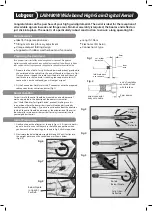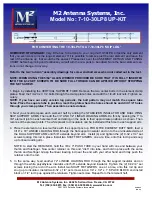
LAB480W Wideband High Gain Digital Aerial
•
Ideal for fringe reception areas
•
Tilting mast clamp for easy adjustment
•
Unique compact folding design
•
Supplied with rubber weather boot and f connector
•
Length: 1.08m
•
Electronic 75Ω balun
•
Connection: F type
Congratulations on the purchase of your high gain digital aerial. The aerial is ideal for the reception of
all available signals in weak and fringe areas. Minimal assembly is required, the booms and reflectors
just click into place. The aerial is of a particularly robust construction to ensure a long operating life.
For optimum results install the aerial using double screened CAI approved
digital coax cable and screened coax outlets (not supplied). You will need to fit the
coax cable with the F type connector (supplied) to connect to the aerial balun.
1. Prepare the Coax Cable: Firstly fit the rubber weather boot provided, to
the aerial end of the cable. Strip the end of the cable as shown in Fig. 1.
Once you have stripped the cable, twist the braid and pull it back on
itself, make sure that no braid is touching the copper core, this will
cause a short on the cable and you will not get a signal.
2. Fit the F connector: Simply twist the ‘F’ connector onto the prepared
cable end and trim central conductor (Fig. 2).
fold braid back
over sheath
8mm
inner
wire
cut or tear
away foil
Fig. 1
screw connector
body onto cable
2mm approx.
end of insulation
should be flush
with this face
Fig. 2
For best results the aerial should be mounted on an outdoor aerial
mast and pointed in the direction of the nearest transmitter
(see: “Useful Websites for Digital Advice” overleaf) making sure it is
in a position where the transmitter signal will not be obstructed by
nearby trees and buildings. If you are in any doubt about the direction
in which the aerial should be pointing or the orientation of the aerial
(horizontal for main transmitter, vertical for relay transmitter) check
your neighbours’ aerials.
1. Gently pull open the reflectors as shown in Figs. 3-4. It is best to do this
one at a time. You can tell they are in the fully open position when
you hear each of the locating pins shown in Fig. 5 click into position.
2. Next rotate the balun/dipole assembly through 90˚until it clips into
the upright position on the central boom as shown below.
(Fig. 6-8)
Fig. 3
Fig. 4
Main Features
Preparing the downlead
Aerial Location
Aerial Preparation
Fully Open
Reflectors
Fig. 4
Fig. 5
Upper
Reflector
Lower
Reflector
Balun/Dipole
in Upright
Position
Rotate
Balun/Dipole
Fig. 6
Fig. 8
Fig. 7



















